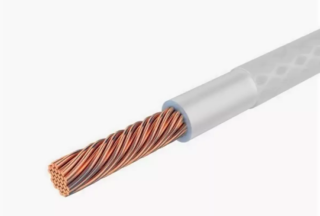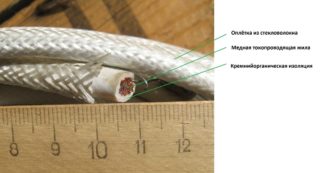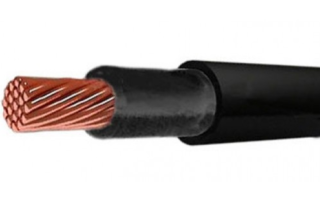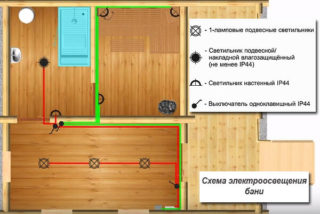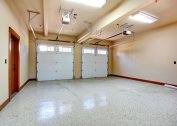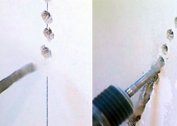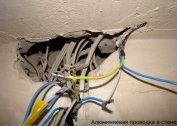Any rooms with high humidity require a special approach to the wiring device. This is especially true for saunas and baths. Moisture and high temperatures can trigger serious emergencies. To prevent this, during the construction of such facilities use a special wire for the bath heat-resistant.
What is a heat resistant cable
Masters call a heat-resistant wire a separate type of cable product. It is characterized by increased resistance to high levels of humidity under the condition of regular high temperatures.
The peculiarity of such a cable is that it has an additional protective braid of non-combustible materials. These cables are used in facilities with extremely high temperatures: hot shops, saunas, baths, bakeries, etc.
There are several varieties of heat-resistant wires for a sauna. All of them differ in the range of maintained temperatures. Each of them has its own special marking.
Types of heat-resistant cable
One of the main conditions for the safe installation of electricians in rooms with high temperatures and humidity is the thermal stability of the wiring. But here it is important to understand that a sauna or a bathhouse has two categories of premises:
- with standard temperature conditions: hall, lounge, room with pool;
- steam room: a room with high rates in Celsius.
For standard rooms it is allowed to use such types of cables as AVVG, VVG, NYM or PVA. Their braid consists of polyvinyl chloride, cross-linked polyethylene or other insulating materials. It is possible to lay such wires in a hidden or open way. The main thing is that they are carefully insulated along the entire length.
It is advisable to use a special polymer (but not metal) corrugation as an additional protective channel for wires.
Cable for steam rooms
In rooms with constantly or regularly high temperatures, only heat-resistant wire is used for saunas and baths. If you do not adhere to this recommendation, the braid of an ordinary cable melts when the degrees in the room increase. In this case, fire is not excluded. To install electrics in pairs, you can use one of several types of cable below.
RKGM
The product labeling stands for “silicone rubber + bare copper core”. The main advantages of such a wire:
- does not support combustion;
- inert to regular drops in blood pressure;
- resistant to mold;
- withstands not only vibration, but also mechanical stress;
- inert to solar radiation, radiation.
This type of cable can be operated at a humidity of 100% and a maximum temperature of up to +180 degrees.
PRKA
 The marking of this product is interpreted as follows:
The marking of this product is interpreted as follows:
- P - wire with a copper conductive core;
- RK - silicone rubber (upper braid);
- A - increased hardness.
Advantages of the named wire for the bath:
- inertness to burning;
- lack of halogens in the braid;
- resistance to radiation, ultraviolet, mold;
- increased flexibility.
The PRKA cable is allowed to operate at a humidity level of 98% and an extreme temperature of up to +180 degrees.
PVCW
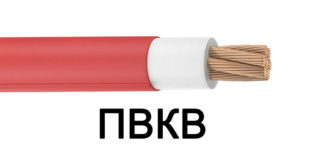 The interpretation of the marking is as follows:
The interpretation of the marking is as follows:
- P - wire;
- In - a conclusion of electric cars;
- KV - silicone rubber two-layer as a braid.
Use such a cable with a Class H winding output device.
The main advantages of the wire:
- increased flexibility (up to 20 cycles of position change);
- resistance to atmospheric pressure drops;
- inertness to vibrations, mechanical stress;
- Does not support melting or burning.
The maximum allowable operating temperature is +180 degrees.
PAL
The marking is deciphered as follows:
- P - wire;
- A - asbestos braid;
- L - varnish coating.
Features of the PAL cable:
- toxic safety under the condition of operation from -50 to +200 degrees (with increasing temperature, the varnish emits toxic fumes);
- the ability to withstand indicators up to +300 degrees Celsius for about 3,000 hours;
- inertness to the effects of technical toluene, gasoline, silicone varnish.
PAL can withstand up to 20 free bending cycles without violating the integrity of the conductive core and insulation.
PNBS
Marking is interpreted as “a wire motionless for a bath, a sauna”. This cable is used specifically for electricians for heating furnaces, heating equipment operating at constantly high temperatures in the room. The product is ideal for hot, humid rooms.
The wire for the PNBS sauna and bath differs in such technical characteristics:
- permissible temperature limit - up to +150 degrees;
- the presence of copper conductive conductors with silicone rubber braid;
- fluorosiloxane rubber sheath;
- the ability to directly connect the cable to the heating equipment.
The operation of this wire in saunas and baths is regulated by the PUE.
PMTK
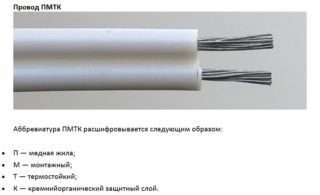 Here, the product marking stands for “heat-resistant mounting wire with silicone rubber braid”.
Here, the product marking stands for “heat-resistant mounting wire with silicone rubber braid”.
The cable has a multi-wire copper conductive core. This type of product can be used in rooms with a maximum Celsius up to +200 with a maximum humidity of 100%. If you run a single installation, the cable sheath does not support combustion.
PRKS
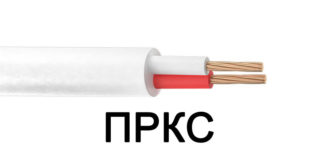 The marking translates as "wire with rubber silicone insulation for the sauna." Cable insulation is inert to gasoline and oils. The product is highly flexible. It is possible to operate a wire for a steam room moisture-, heat-resistant marking PRKS at a maximum temperature of up to +250 degrees. Through one cable due to its multi-core power can transmit power up to 30 kW.
The marking translates as "wire with rubber silicone insulation for the sauna." Cable insulation is inert to gasoline and oils. The product is highly flexible. It is possible to operate a wire for a steam room moisture-, heat-resistant marking PRKS at a maximum temperature of up to +250 degrees. Through one cable due to its multi-core power can transmit power up to 30 kW.
Standards and requirements for posting in the bath
Fire safety rules regulate the special rules of the device of electricians in rooms with a high level of humidity and temperature. You need to rely on such requirements:
- Be sure to install automatic locks during installation work to protect power lines.
- It is important to provide a potential equalization system (CPS).
- All wiring is laid with TN-C-S ground. If it is impossible to comply with these conditions for technical reasons, the electric power supply is performed using a pressure transformer.
- All wires are laid only vertically or horizontally. Diagonal channels or strobes are not allowed. Turns do only 90 degrees.
- The distribution panel is mounted as close as possible to the entry point of the lead wire for the sauna.
- The cable is pulled in whole cuts. Excluded options for mounting the line in separate pieces with unnecessary connections. Joints are permissible only in special junction boxes.
- Horizontal strobes or channels are placed 10-20 cm from the ceiling and floor.
- From windows, doors, the cable is removed 10-15 cm.
- The switches are mounted 30 cm from the sockets and 1 meter from the floor.
- From any metal devices (batteries, electric radiators), wires are removed at least 50 cm.
- Power points need to be located 60 cm from the shower.
- All fixtures must be airtight. The optimal power of the bulbs is 60 watts.
- It is forbidden to mount open power points (sockets, switches) directly in the steam room, shower or in a room with a pool.
Compliance with these rules insures the owner of the sauna and its visitors from injuries and fires.
As a rule, in a sauna, household standard appliances are used: a hairdryer, a kettle, a music center, lighting points, as well as electric heating devices: radiators, stoves for a steam room. Therefore, it is advisable to make an optimal voltage for a 10 kW sauna. If the bath does not have electric heating and heating equipment for a steam room, you can limit yourself to a 220-watt network from the house.
Cable routing methods
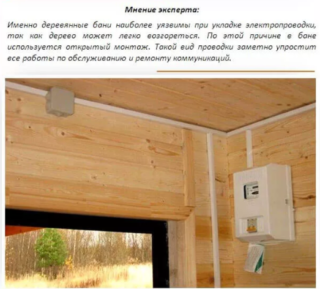 Doing it yourself in the bathhouse is done in two ways:
Doing it yourself in the bathhouse is done in two ways:
- By air. This method of cable routing along the street is characterized by relative cheapness, high speed of the process and moderate laboriousness.
- Underground. Here you will have to spend more effort, time and money on the device power lines. But the underground method of supply ensures the safety of the cable from mechanical influences, vandals, etc.
Previously, a power cable is brought to the box of the building.
Postings on the building itself can be laid open or closed. This is permitted by standards. In the first case, it is relevant to perform retro wiring in the bathhouse. This is a cable stretched over internal walls using special fasteners.
Before starting installation work, it is necessary to draw up a wiring diagram.
Common wiring errors
The main flaws when choosing a wire for a humid hot room:
- purchase of a standard cable for laying in a steam room instead of heat resistant;
- Incorrect cross-section of the supply wire required for the electric furnace.
If these errors are avoided, all work on the device electricians are considered performed correctly and in accordance with GOST.
